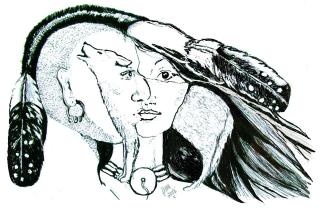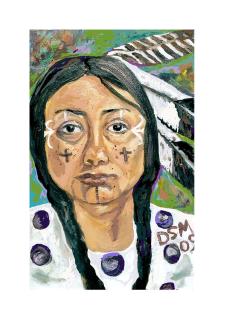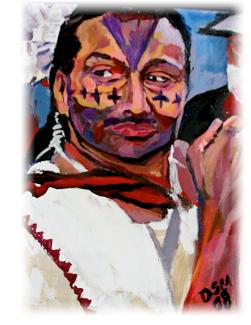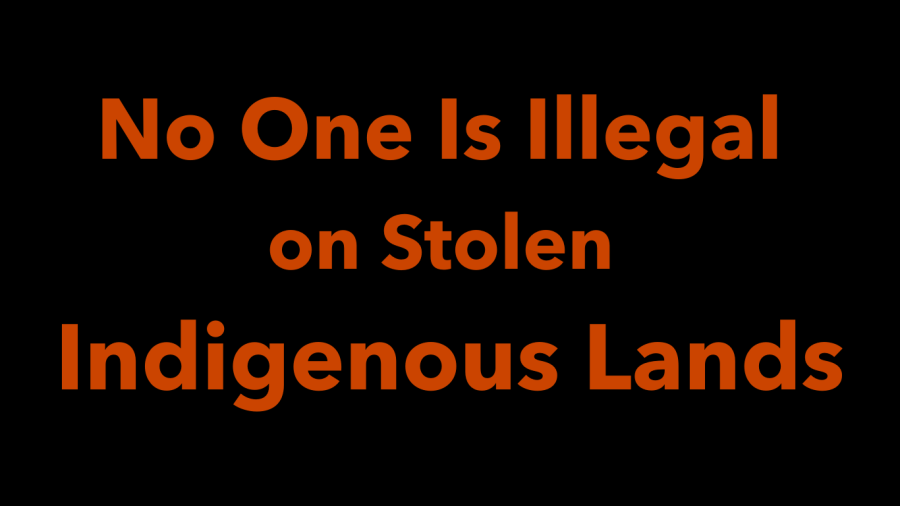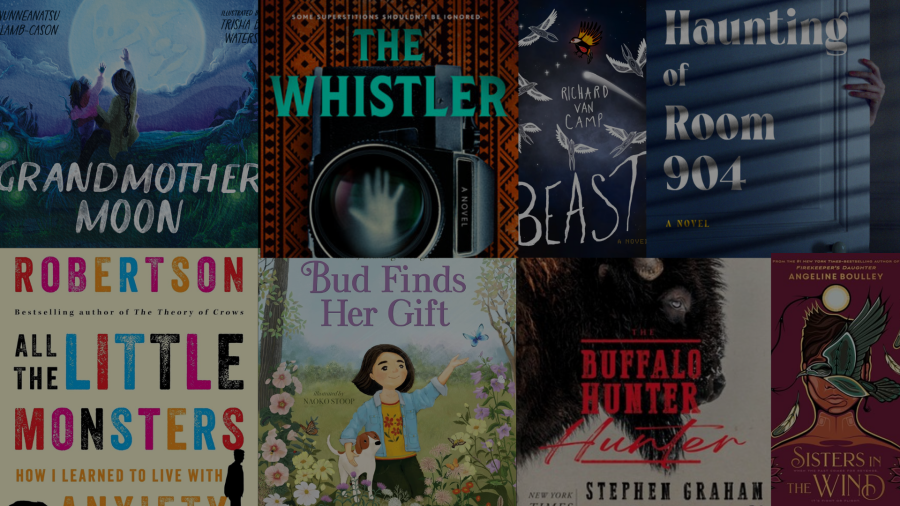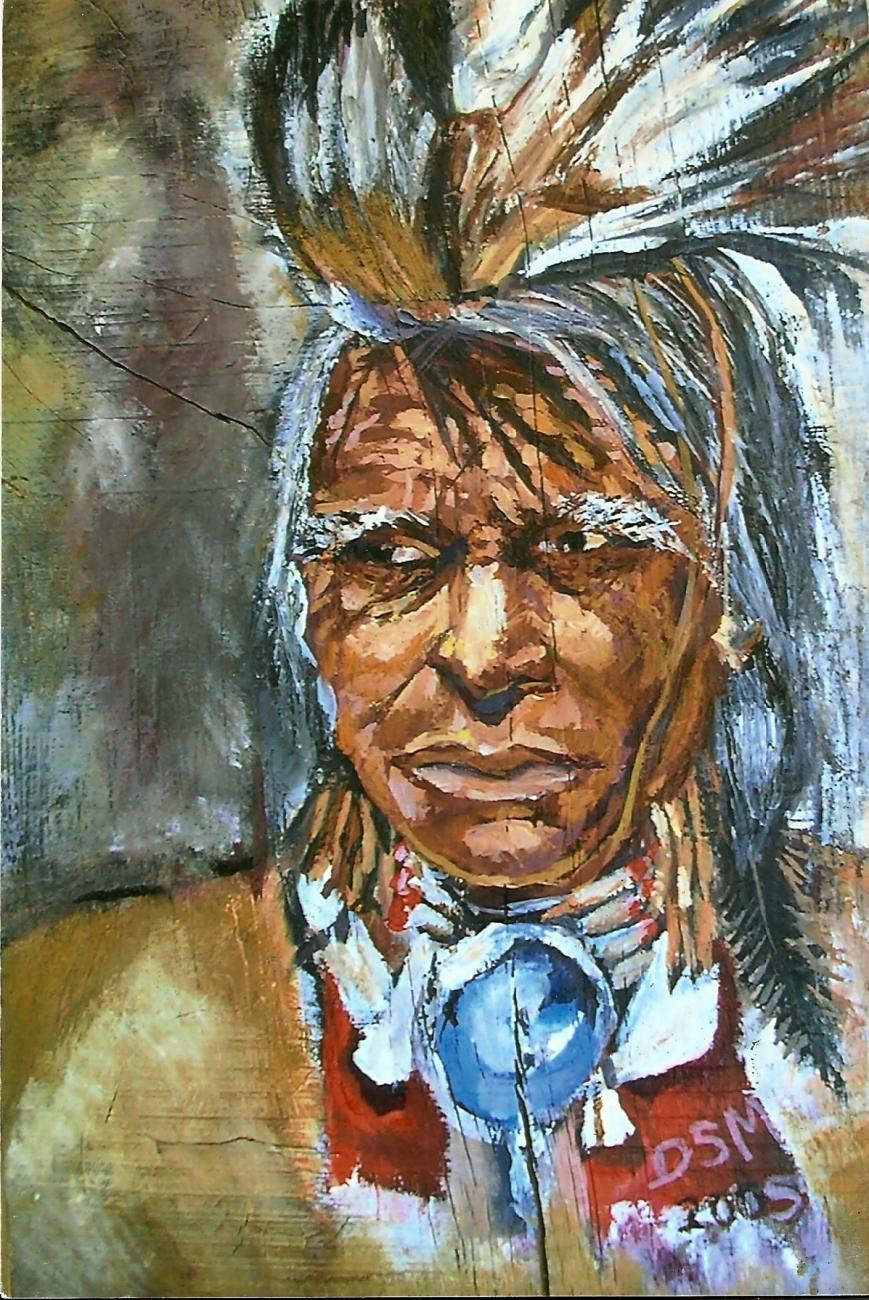
By Hannah Ellman
Deborah Spears Moorehead, an artist from the Seaconke, Pokanoket, Wampanoag, Narragansett, Pequot, Mohawk, and Nipmuc Tribal Nations, has been drawing since she can remember. Moorehead states, “The Creator chose me to have the talent to be an artist…I started drawing when I was old enough to pick up a pencil.” Her draw towards artistic forms of expression follows in a line of familial connections to art. There’s “artistic talent, on both sides of my family,” Moorehead explains. She recalls watching her mother create “beautiful renderings of people that she knew,” and drawing during family visits to her grandparents. “My grandmother would just give me…a paper and pencil and…tell me to draw anything that was in front of me.”
“As I got older, I realized I was an artist,” Moorehead explains. During her middle school years, an experience at a lifelong friend’s house helped Moorehead to choose her current medium: oil paint. “[My friend’s] mother gave us a canvas and paint, oil paint, and I painted a raccoon. I fell in love with oil paint from that day on.” While oil paint continues to be her medium of choice, Moorehead usually begins with colored pencils. “I like to use colored pencils to do a study of what I’m going to paint so that I can work out any problems with color before I get into the oil painting.”
After receiving her Bachelor’s from the Swain School of Design, Moorehead continued her studies at Goucher College, earning a Masters of Arts in Traditional Cultural Sustainability. Today, she run’s her business, the Painted Arrow Studio – Talking Water Productions, in Richmond, Rhode Island. Through her studio, Moorehead not only designs, produces, and sells her art, music, and jewelry, she also organizes and coordinates art shows and musical performances, and teaches private art lessons to children and adults alike.
In terms of her individual work, Moorehead focuses on the Eastern Woodland Native American community. She recalls being a young student in school, learning from curricula that taught her that Eastern Native Woodland peoples were extinct. “That made it really difficult for me to develop an identity, when all society was telling me that I didn’t exist.” This experience repeated itself when Moorehead attended college in Massachusetts. “The professors were teaching the art of European people,” and she “constantly yearned for a Native American teacher who would teach the history of the Native Americans and their art.” These experiences led Moorehead to a decision that continues to shape her work; “When I was old enough to assert my own way of identity… I decided that, well, as an artist, I’m going to paint my people and document that we’re here. And if we’re here now we had to have been here in the past. If we’re here now, we have to be here in the future.” Today, her goal is to create pieces that will collectively validate all forms of Eastern Woodland Native identity: past, present, and future. She continues to document, through what she describes as “pinpointing the obscurity of the people. It’s saying, you know, our history was obscured for certain reasons, but it can’t be obscured if I say and paint, “here we are, right now, we’re here and have always been here!””
Moorehead’s work, therefore, functions as a part of the process of rewriting an accurate history, one that does not relegate Native people to the margins, and one that connects Native peoples within and between communities and across borders. Her pieces have been displayed in schools, universities, museums, libraries, and a variety of other public venues across the country, including (but not limited to) the Mashantucket Pequot Museum, Brown University, Harvard University, The Museum of Fine Arts, The Rhode Island School of Design, and The Mohegan Tribal Nation. Her work has also been displayed internationally, for example, in the International Gallery of Bolivia. Both domestically and internationally, Moorehead hopes that her work speaks “the language to all indigenous people that we all have a lot of work to do.” Her intent, to link indigenous peoples together on a global level, centers itself on survival and cultural sustainability. “Our survival is very critical. We’re only one percent of the population so it’s very critical that we protect the traditions, the culture, the people [and] a lot of indigenous people are facing the same kind of issues that we’re facing,” Moorehead states.
Moorehead’s drive and deep-rooted beliefs about her art and teaching have led her to a variety of fascinating and rewarding experiences. In 2006, she was awarded the Youth Mural Project Grant. Through this grant, she collaborated with the Tomaquag Indian Museum and students from the Nuweetooun School to create a mural entitled, “Nuneechun NuPeesh Kanashunun,” or “Our Children, Our Future,” “working to sustain the culture and the survival of [Eastern Woodland] people,” specifically the next seven generations, “through lessons of healthy alternatives of living.” The mural project emphasized the importance of being “witnesses of colonization” and pushing back against the effects of that colonization. Moorehead explains that the best part of the experience was working one on one with the children, continuing in the tradition of her ancestors. “It was an honor to be able to do that at the Tomaquag Memorial Indian Museum [and] to be able to teach the children.”
More recently, Moorehead has furthered her outreach into the community, working as the curator this past year for the first annual state Native American Art Exhibit at the Rhode Island State Council. The exhibit endeavored to highlight the work of Eastern Woodland Native Artists. For, as Moorehead states, too often, underserved artists “are intimidated to be in venues that they’re not familiar with.” The mission of the exhibit was to work towards artistic cultural democracy, the idea “that all people – every culture, every nationality, every ethnicity, everyone – should be equally able to participate in the arts.” Moorehead states, “I really get a lot out of working with Rhode Island State Council of the Arts. They pretty much help me put to practice the training that I received in my Master’s Degree: Masters of Arts and Cultural Sustainability.”
Highlighting the need for even more advocates for artists like those presented at this particular exhibit, Moorehead asserts, “we need people from outside the community to advocate for us to advocate for ourselves. It’s advocating from inside and out.” More specifically, “there needs to be advocates that can help or assist Native artists, you know, find the talent, then assist the artists to be ready to present themselves in a professional manner,” and eventually to become welcomed representatives of and advocates for their communities in a broader sense.
In reference not only to her work with the Rhode Island State Council of the Arts but also to her own beliefs, Moorehead emphasizes the need for this form of democracy as connected to sovereignty and cultural sustainability. “I think one of the most prominent issues for Native Americans today… is our sovereignty. We are sovereign nations; we need our land to be able to sustain our culture; we need the environment to be protected…[and] there needs to be more cultural policies that emerge that can assist Native people with being advocates for themselves. We need free prior and informed consent when decisions are being made that affect our environment; we need advocates that assist in all ways for readiness, as representatives of our nations.”
In terms of her own role in this process of working towards resolving these issues, Moorehead states, “I see my work as a way of communicating an injustice to indigenous people, and I find that my Masters Degree has given my paintings more to say. My daughter said at one point, “Mom, this degree has given your paintings a voice,”” and that voice is one that speaks out for social justice. “I believe that art has its own language. And like they say, a picture speaks a thousand words.” Moorehead works, not only to bring out that voice from within herself, but also to bring out that voice from within others. “As a teacher I can assist anyone to express whatever they want to communicate…It’s hard to paint something that you’re not feeling, and it’s hard to, you know, not feel when you’re painting.”
Advocacy for and by Native peoples, accurate and thoughtful documentation of Native life, and the creation of connections across Native boundaries and cultural lines; as Moorehead illustrates, perhaps the universality of art opens up an ideal space for taking these crucial steps towards multiple forms of cultural democracy. “It doesn’t matter what community you come from,” Moorehead claims, “like I said, art has it’s own language and we all speak that same language.”
Come visit Deborah at the Cultural Survival Bazaars.
